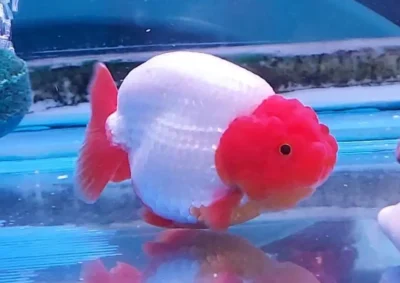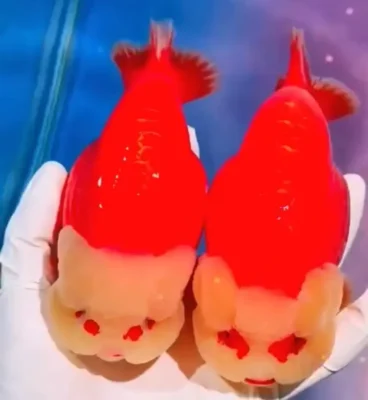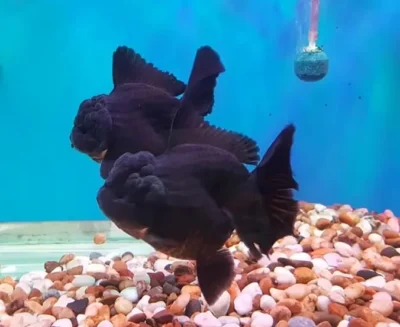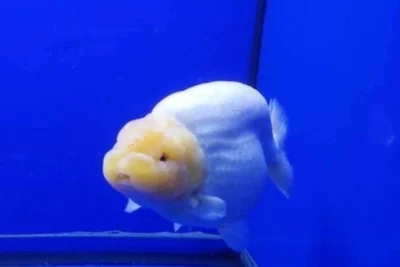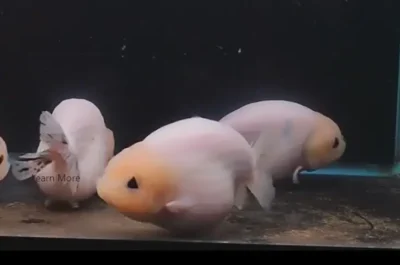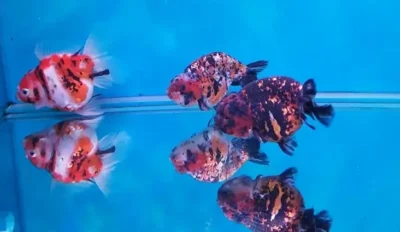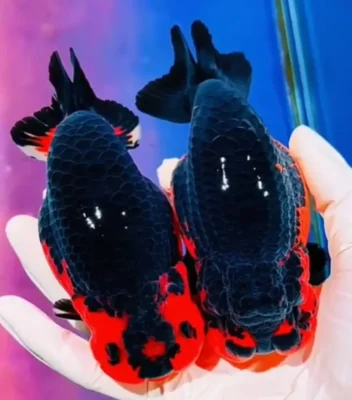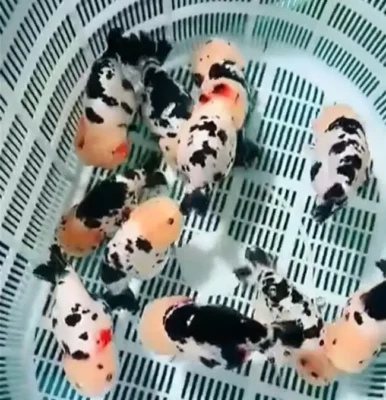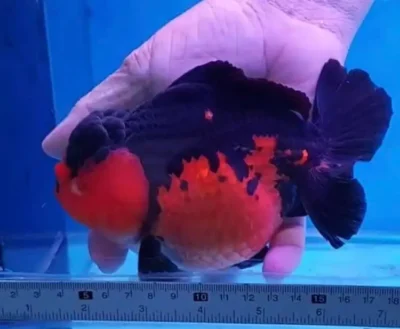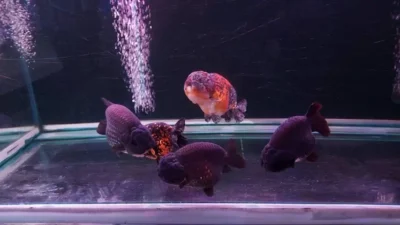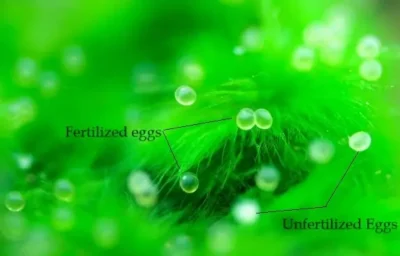Ranchu Goldfish is also called the “king of Goldfish”. The Ranchu goldfish originated in Japan and is a popular and distinctive variety of fancy goldfish. It is characterized by a short, round body, a hump on its back, and a lack of a dorsal fin. The hump on its back is a key feature that distinguishes it from other goldfish varieties.
Another prominent feature of Ranchu is the “wen” or head growth, which covers the top of its head and extends to the sides of its face. Ranchu goldfish are not strong swimmers compared to other goldfish types due to their body shape.
Fish enthusiasts highly prize the Ranchu goldfish, due to their unique appearance and looks. Taking care of Ranchu goldfish requires attention to water quality, proper nutrition, and an appropriate environment to ensure their well-being.
Ranchu Goldfish Varieties:
Ranchu goldfish come in different varieties, and can be classified based on factors such as color, pattern, Head and fin. Ranchu comes in major base colors like Orange, red, white and black. You can also find other color variations like chocolate Ranchu and calico Ranchu and Milk cow Ranchu.
Here are some common Ranchu goldfish varieties based on their color, body and Head patterns:
Lionhead Ranchu Goldfish:
The Lionhead Ranchu is a specific variation of the Ranchu goldfish. The Lionhead Ranchu is characterized by a pronounced head growth and wen extends to the sides of its face, resembling a lion’s face. This feature sets the Lionhead Ranchu apart from other Ranchu varieties.
Lionhead Ranchu can come in various colors, including red, white, orange, yellow, and calico patterns. The coloration can vary, and breeders often strive for vibrant and well-defined colors.
Black Ranchu Goldfish:
Black Ranchu goldfish have a solid black coloration. The main feature of the Black Ranchu is its deep, solid black color and the quality and intensity of the black color may vary depending on various factors.
Red Ranchu goldfish:
The Red Ranchu variety is known for its vibrant red color. The intensity of the red color can vary, and some Red Ranchus may have other color markings on them. A well-balanced diet is crucial for it to maintain its of Red coloration.
Red and White Ranchu: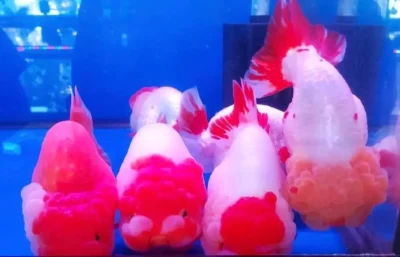
Ranchu is a fancy goldfish breed that originated in Japan.The Red and White coloration is a typical color pattern found in most Ranchu goldfish. These fish are often red and white in color, with variations in the distribution of their colors. Their body may have patches or areas of red, white, and black which creates a visual appeal.
Lemon Head Ranchu:
Lemon Head Ranchu goldfish areis another popular variety of Ranchu known for their Lemon colored yellowish head and white bodies. Lemon Head Ranchus are relatively easy to care for and its colour make a great addition to the Ranchu aquqrium tank.
White Ranchu goldfish:
The White Ranchu goldfish that predominantly exhibits a white coloration through the body and head. White Ranchu goldfish distinctive appearance makes a great addition adding beauty to the Ranchu Aquarium tank.
Calico Ranchu:
The Calico Ranchu goldfish exhibits a calico color pattern. Calico Ranchu typically have a mix of three colors such as red, white, and black. The calico pattern appears as spots, patches or markings on the entire body and fins. Each individual Calico Ranchu can have a unique and visually appeal making it a great addition to any Ranchu Tank.
Jumbo Ranchu goldfish:
Jumbo Ranchus is a larger or jumbo version of the classic Ranchu goldfish. They are known for their exceptional size and beauty. While standard Ranchus typically reach around 3-5 inches in length, Jumbo Ranchus grow up to 6-8 inches. This impressive size makes them truly stand out in any Goldfish aquarium.
Milk Cow Ranchu:
The Milk Cow Ranchu is a variety of Ranchu goldfish that boasts a distinctive pattern reminiscent of a cow. Unlike the orange and red color associated with Clasical Ranchu goldfish, the Milk Cow Ranchu has a Black and white spotted pattern that features across the body in varying degrees.
Thai Ranchu:
Thai Ranchu goldfish are a popular variety of goldfish that are known for their stunning appearance and beauty. Thai Ranchu are a type of Ranchu goldfish, which are characterized by their short bodies, big egg shaped head. Thai Ranchus are a special Ranchu breed that are native to Thailand. Thai Ranchus are large in size and can grow up to 8 inches and above in size.
Ranchu Lifespan:
On average, the lifespan of a Ranchu goldfish is between 10 to 15 years. Some exceptional ones can live longer than 15 years. Like many other goldfish varieties, the Ranchu Lifspan can vary based on several factors such as water quality, their living environment, care, and genetic factors.
Providing proper care is the key to the longevity of a Ranchu Goldfish. Proper Care includes maintaining a clean and adequately sized aquarium or pond, providing a balanced and nutritious diet, Regularly monitoring water quality, and addressing any health issues promptly.
Ranchu goldfish can live longer than their average lifespan if they receive exceptional care and are kept in good water conditions concerning water temperature, pH and optimal hardness with low nitrate levels. To increase the lifespan of Ranchu Goldfish make sure that the water is just 1 degree warmer than the optimization temperature. Since Ranchu are not great swimmers their metabolic activity will be a little bit on the lower side. A mild warmer temperature avoids infections as bacteria do not survive and multiply in warm temperatures. Also, Ranchus remains active in warmer temperatures which can increase their metabolic activity.
Ranchu Goldfish Tank size:
The size of the Ranchu goldfish tank depends on several factors, including the number of Ranchu fish, their size, and your ability to maintain water quality.
As a general rule of thumb, a single Ranchu goldfish requires a tank size of at least 20 gallons. However, it’s important to note that Ranchu goldfish are social animals, and they thrive better when kept in groups. To keep multiple Ranchu goldfish, you should increase the tank size accordingly.
Here are some recommendations based on the number of Ranchu goldfish:
Single Ranchu: 20 gallons or more.
Pair of Ranchu: 30 gallons or more.
Small Group (5-6): 60 gallons or more.
Ranch Fish Tank Size:
Additionally, Ranchu goldfish can grow quite large, and their waste production is relatively high. A good filtration mechanism is crucial to maintain good water quality. A canister filter or a powerful aquarium filter is recommended for Ranch goldfish tanks.
Maintaining proper water parameters, including temperature, pH, and ammonia levels, is essential for the health of your Ranchu goldfish. A 30% water change weekly or once in 15 days depending on the size of your Ranchu Tank is needed. Adding a few plants to your tank can keep the stress levels low for your fish.
Ranchu Goldfish Water Parameters:
Ranchu goldfish, like any other goldfish varieties, have specific water parameter requirements for optimal health. Here are the recommended water parameters for Ranchu goldfish:
Temperature: The ideal temperature for Ranchu Goldfish is between 78-85°F. Ranchu goldfish can tolerate a range of temperatures depending on the location they are raised, but it’s important to avoid sudden fluctuations in temperature.
pH Level: Maintain a pH level between 6.5 and 8.5. Ranchu Goldfish can tolerate a slightly wider alkaline pH range, but keeping it within this range is generally recommended.
Ammonia and Nitrite: Ammonia and nitrite are harmful to fish, so it’s ideal to keep them near zero. Use a reliable filter and perform regular water changes to help maintain these water parameters.
Water Hardness: Ranchu goldfish can adapt to a wide range of water hardness levels. Ideally, keep the water hardness between 5-30 dGH.
Water stability: Maintaining stable water conditions with very little or negligible water flow currents is essential for the health and well-being of Ranchu goldfish. Make sure that the water currents are not high due to aquarium motor pumps and aquarium filters. Strong water currents might cause stress to the fish as they need to swim against the water current.
Ranchu Diet:
Ranchu goldfish require a balanced and varied diet to stay healthy. Here are diet options for feeding Ranchu goldfish:
High-Quality Pellets: Choose a high-quality pellet-like food that is specifically formulated for Ranchu goldfish. Look for a food that provides all essential nutrients and is specially made for fancy goldfish varieties. Feed them in small quantities two to three times a day based on their size. Consider providing them with Sinking Pellets. Ranchu goldfish have a body shape that can make it challenging for them to reach the surface for floating food.
Live or Frozen Foods: Offer occasional treats of live or frozen foods such as brine shrimp, bloodworms, daphnia, or tubifex worms. These foods can add variety and provide additional nutrients.
Vegetables: Occasionally supplement their diet with fresh vegetables like lettuce, peas, and cucumber. You can cook them if they are too hard. The vegetables need to be finely chopped to make them more easily digestible. Vegetables not only provide nutritional value but can improve their digestive system. It can prevent bloating problems for Ranchu.
Avoid Overfeeding: Ranchus are prone to overeating, which can lead to health issues and the leftover food can create water quality problems. Feed them only what they can consume in a few minutes.
Ranchu Tank Mates:
Ranchu goldfish are generally peaceful and slow swimming due to their body shape. This can make them vulnerable to more active and aggressive tank mates. Here are some suitable tank mates for Ranchu goldfish which are slow swimmers:
- Orandas
- Ryukins
- Bubble Eye Goldfish
- Celestial Eye Goldfish
- Discus Fish
- Dojo loaches
- Bristlenose Plecostomus
- Siamese Algae Eaters
Avoid tank mates who are known to be nippy, aggressive, or fast-swimming, as they may stress or harm the Ranchu goldfish.
Ranchu breeding:
Breeding Ranchu goldfish can be a challenging endeavor if you are a new goldfish hobbyist. The breeding process involves the male Ranchus chasing the female ones, the female laying eggs, and the males fertilizing the eggs through their sperm. Here are some tips and steps for breeding Ranchu goldfish:
Set Up a Breeding Tank:
- Use a separate breeding tank with a minimum size of 40-50 gallons that has enough space for the breeding pairs.
- Use a gentle filtration system to avoid sucking up eggs or fry.
- Add a good amount of plants to the tank to keep them stress-free and happy. A happy environment can encourage the mating process.
- Add a few decorations like driftwood and spawning mops for the eggs to stick on the
Selecting Breeding Pairs:
- Ensure that the breeding pairs are mature enough typically around 2-3 years old. Select 3 male Ranchus and 2 female Ranchus.
- Choose the desired Ranchu traits you are looking for, such as a rounded body, even head growth, and bright colors.
Conditioning:
- Feed the breeding pairs with a high-quality diet rich in protein. Live or frozen worms can be included to enhance their nutritional intake.
- Maintain the water temperature between 78-81°F. Gradually increase the water temperature for a week to raise the temperature between 82°F to 87°F. Maintain that stable water temperature between 82-87°F to simulate the onset of the summer season. Ranchu breeds only during hot weather conditions.
Monitoring Behavior: Monitor for the Ranchus shows signs of chasing, or courtship behavior. If the female Ranchu is receptive, she will respond to the male’s advances.
Spawning:
- Egg Laying: Female Ranchu goldfish scatter their eggs on plants and spawn mops and tank decorations. The males would immediately fertilize by releasing their sperm immediately.
- Egg Collection: If possible, move the eggs to a separate hatching tank or remove the parents to protect eggs from being eaten by the parents. The unfertilized eggs look opaque while the fertilized eggs would look transparent in a day.
Fry Care:
- The eggs will typically hatch within a few days. Once hatched, the fry will consume their yolk sacs initially.
- Provide the fry with powdered fry food. As they grow, you can transition to finely crushed flakes.
- Once the fry becomes large enough you can place them into their parent tank.
Breeding Ranchu goldfish requires patience, attention to water quality and parameters, and a good understanding of their specific needs. Additionally, extra care should be provided to the fry until they develop into juveniles.
Ranchu Health and Diseases:
Maintaining the health of Ranchu goldfish involves providing them proper care, and maintaining ideal water conditions.
Signs of Illness:
- Changes in Behavior like Lethargy, abnormal swimming patterns, or hiding.
- Physical Changes like abnormal growths on the head, discoloration, fin clamping, or changes in appetite.
- Respiratory Issues like rapid breathing or labored breathing, gasping at the water surface.
- Flicking or Scratching against objects or flicking their bodies that indicate irritation or parasites.
If you notice any signs of illness, it’s crucial to isolate the affected fish so that the disease does not spread to the other healthy Ranchus. Identify the specific issue, and administer appropriate treatment promptly.
Here are some potential diseases that can affect Ranchu goldfish:
Ich: A common parasitic infection that causes white cysts on the skin, gills, and fins. Treat them with aquarium salt and anti-parasitic medications.
Fin Rot: Bacterial infection that leads to the deterioration of fins and tail. Maintain clean water, and treat them with aquarium salt and antibiotics.
Dropsy: Dropsy is Characterized by a swollen body due to the buildup of fluid inside the body cavity or tissues of the fish and distended scales of the fish. Quarantine the fish and address underlying causes, such as bacterial infections, with appropriate medications.
Anchor Worms: Anchor worms are external parasites that appear as thread-like worms attached to the fish. Remove manually with a plucker and use anti-parasitic treatments.
Swim Bladder Issues: This can cause buoyancy problems, making the fish float or sink. Address underlying causes, such as overfeeding or constipation. Stop feeding the Ranchus for a day or two and feed them vegetable matter such as chopped peas and lettuce for a few days.
Lice and Flukes: Lice and Flukes are External parasites that can be seen on the skin and gills. Treat them with anti-parasitic medications.
Ranchu Goldfish Price:
The price of Ranchu goldfish varies depending on factors such as the size of the fish, color, markings, Pattern, and overall quality. Additionally, prices may differ based on the location and the availability of specific varieties. Here are some general price ranges to give you an idea:
Young or Common Varieties:
Young Ranchus or less-developed Ranchu goldfish may be available for $10 to $30, depending on size and quality.
High-Quality Juveniles or Young Adults:
High-quality Ranchu with beautiful rare traits and show quality ones can range from $50 to $150 or more.
Show-Quality Adults:
Fully developed show-quality Ranchu goldfish with exceptional features can be priced at $150 and upward, with some rare or highly sought-after Ranchus commanding even higher prices.
It’s important to note that the prices mentioned above are general estimates, and actual prices can vary based on the factors mentioned earlier.
Ranchu Goldfish for Sale:
You can find Ranchu goldfish for sale through various channels. Here are some suggestions:
Local Aquarium Stores: Google and visit your local aquarium stores that specialize in fish. They may have Ranchu goldfish for sale, or they can point you to reputable breeders.
Online Retailers: Numerous online retail platforms specialize in selling fish. Ensure that you choose a reliable and reputable seller. Some websites allow you to purchase directly and deliver to your place.
Facebook groups: Look at a Rachu-selling Facebook group and get in touch with the breeders. Some breeders ship fish directly to customers across locations.
Before making a purchase, do thorough research on the seller, inquire about the fish’s health get photos and videos of the fish, and ask for any relevant details about the Ranchu you’re interested in.

